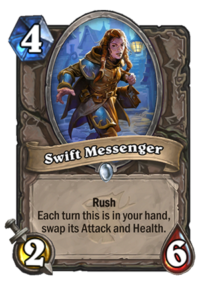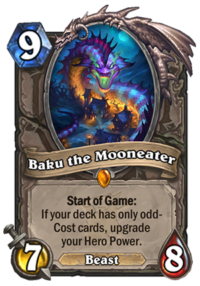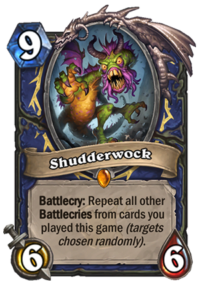As brave Redditors keep on trying to summon the announcement for the upcoming Hearthstone year, it’s high time to take a look at the three sets that are leaving Standand with the upcoming rotation. What did The Witchwood bring to the table and how impactful was it? With one keyword a permanent fixture two years later and the Baku/Genn duo warping the game around themselves, it’s safe to say it was an impactful expansion even though many classes received pitifully weak cards.
Echoes of the Past
It says a lot about the Echo keyword that the most heated discussion about it was a consistency issue with Witch's Brew, which didn’t feature it in Rise of Shadows despite an otherwise appropriate card text. Echo makes a card repeatable on the turn it was played, an effect which grants flexibility and a lot of potential value for just a single card. However, just like in so many other cases with interesting niche effects like these, Team 5 priced these cards so conservatively that almost all of them struggled to see Constructed play. The two exceptions to these from the set were supported by special circumstances: Phantom Militia was an important three-in-one for Taunt Warrior back in the day, and Warpath was a great and flexible AoE tool. However, it’s worth noting that it also didn’t see play for a long time due to the strength of Reckless Flurry with Tank Up!, which is something we’ll get into later down the line.
Ultimately, these cards were just too slow to play out for a decent value and too brittle to make it worth to run them when casting them just once or twice. It hasn’t been featured in any sets since, apart from SN1P-SN4P, a card which is technically a part of The Boomsday Project but is a special event reward. Its base form actually has an extra stat compared to Harvest Golem, which instantly makes it a much more tantalizing proposition – Magnetize is just a cherry on top. Special shoutout to Glinda Crowskin, who may not have found a home in Standard but was an important part of the degenerate SN4Plock deck in Wild which abused animations and turn timers to do some pretty disgusting things. All in all, it feels like Echo on a minion will only be viable with an insane value proposition (not even Face Collector was good enough), making it a better fit for spells like Warpath, Curse of Weakness or the later Witch’s Brew. It doesn’t create interesting gameplay moments and it’s tough to strike a balance where it is playable but not overpowered – it wouldn’t be surprising to see it consigned to the dustbin of Hearthstone alongside Inspire and its fellow ilk.
Rushing the Streets

Over the last two years, Rush has pretty much emerged as the permanent replacement for Charge (which has not been used on a single card since Knights of the Frozen Throne’s Chillblade Champion), providing the same sort of immediate impact on the board without enabling OTK setups. Normally, these cards are meant to sacrifice stats for their instant attack ability – like Rabid Worgen –, but now we’ve pretty much reached a point where they’ve become reliable removal tools with sometimes even the capacity to value-trade. Though the keyword itself is perfectly fine, its stats penalty has gone down over time, which had a negative effect on the gameplay experience, culminating in the initial Galakrond Shaman builds. When both sides are staring at one another with a bunch of Rush cards in hand, aiming to get a value advantage, it’s the exact same sort of hard removal-upon-hard removal feeling like the old Control Warrior decks used to produce.
Though it never even received one of its own, the stat-swapping Worgen cards tie neatly into this discussion, even if they never had any relevance whatsoever in Constructed. Though the fantasy of turning into a werewolf is certainly interesting, once again the minions were just too weak to use, and the shift in stats simply made them unreliable. In Arena, Swift Messenger was a unique annoyance, as even if you had a valid read on your opponent’s hand that they’re lacking hard removal, this card would simply turn into one on the following turn without giving you a chance to plan accordingly. It’s about as important as this ever got.
Even the Odds Are Against Us

Of course, The Witchwood also stands out from the list of expansions because it is the only one in the history of the game to have cards rotated to the Hall of Fame. Genn Greymane, Baku the Mooneater and their support cards rewarded the player for only playing even- or odd-cost cards in their decks, and such archetypes rapidly pushed out almost everything else from the metagame. It also turned out to be a massive headache for the developers, greatly limiting design space while also impacting their nerf potential. You couldn’t just up the mana cost of a problematic card by one if it fit perfectly into an archetype which was previously unable to use it.
What was the issue with Genn and Baku from a gameplay perspective? Genn Greymane made your hero power cost one mana, which guaranteed effective mana utilization and a more streamlined gameplan. Meanwhile, Baku the Mooneater often made it a perfectly reasonable play to just press the button and pass, once again streamlining the gameplan to such extent that an Even or an Odd deck would hardly ever have a “bad” draw in the early game. Since Hearthstone has a guaranteed mana ramp – forgoing Magic’s land system whose inherent variance is responsible for many of the disparate game states in a given matchup – this level of consistency was going to be an issue. They turned out to be overly powerful and meta-defining three sets in a row, and it’s hard to imagine the return of Quests and many other keywords or archetypes from the Year of the Dragon with Genn and Baku still in the rotation. Interestingly, only one of the support cards ever saw play, Even Shaman’s Murkspark Eel. With Iksar’s teaser of soon-to-be-reverted nerfs, one has to wonder whether certain changes made in light of this dastardly duo will be changed around as they enter the jungle that is Wild.
Honorable Mentions

Many of the class cards were surprisingly weak this expansion, though perhaps this makes more sense in light of the strength of Genn and Baku. Druid’s “Handdruid” archetype never got off the ground, though tools like Ferocious Howl and Witching Hour eventually found a way into a Taunt-based archetype. Wispering Woods also served as a useful token generator, but rarely was any consideration made for maxing out your hand size for it. For Hunter, Rat Trap, Dire Frenzy and Houndmaster Shaw had a good run (with Wing Blast making the occasional teck appearance), making it the second-most impactful collection of class cards in the set. Mage occasionally could build around Book of Specters but it ultimately didn’t turn out to be as game-breaking as it seemed at the time, and Arcane Keysmith also became a nice utility tool for slower decks, but the real star of the show was Cinderstorm in aggressive Mage builds.
Paladin, long struggling with identity issues, couldn’t get much out of the mishmash of class cards offered in The Witchwood (though they still had two of the best decks at the time with their Even and Odd builds). The Glass Knight is perhaps the only card with fringe Constructed relevance out of the bunch, with Prince Liam making the occasional tech appearance in Odd Paladin as well. Silver Sword, though worthless in Standard, was a premium Arena pick due to the quite frankly obscene amounts of added stats it could add to your board.
Priest’s set was also of limited use (are you noticing a trend here?), with Divine Hymn becoming a part of certain slower decks, Vivid Nightmare and Coffin Crasher being fringe combo tools… and that’s about it. Rogue’s Burgle identity was pushed really hard in this set (alongside Echo synergies), but Blink Fox was pretty much the only card that made the cut in real decks, most importantly Odd Rogue. Tess Rogue never became a thing – your mileage may vary as to whether that was a good thing or not in the grand scheme of things.

Shaman, the star of the show with Hagatha the Witch and Shudderwock, archetype-defining cards, could also enjoy Earthen Might in certain aggressive decks, but even this 2.5 Constructed-viable tools makes it perhaps the most impactful slate of class cards in the set. To compare, Warlock only had Lord Godfrey to make use of alongside a literal pile of garbage (sorry Glinda). Unsuprisingly, Warrior’s Rush cards – Town Crier, Rabid Worgen, Militia Commander, Darius Crowley – worked great, even if they were power-creeped to oblivion, and the rest turned out to be useless. Woodcutter's Axe, a card clearly meant to fill up the design space freed by the controversial Fiery War Axe nerf, was never really good enough.
Boy oh boy the list of relevant Neutral minions is long. Baleful Banker’s end-game potential, Vicious Scalehide’s proto-Zilliax healing capabilities, Lifedrinker in every aggressive deck, Sandbinder as a flexible utility card, Witchwood Piper in Quest Shaman, Rotten Applebaum and Witchwood Grizzly in most slower decks, usually alongside Mossy Horror, not to mention Azalina Soulthief for rage-inducing moments (mostly in conjunction with King Togwaggle)… also, the two quasi-class cards in the form of Hench-Clan Thug in Rogue and Voodoo Doll in Mage. Many in the community were (and are still) surprised by how little play Countess Ashmore saw, especially in comparison with The Curator, but this is how much it matters that your expensive card draw comes with Taunt or not.
In retrospect, essentially everything in the set is overshadowed by Genn Greymane and Baku the Mooneater, which goes to show how important their premature rotation was for the gameplay experience in The Year of the Dragon. Rush is a great tool in the developers’ arsenal, though, like Discover, it’s getting rapidly overtuned for its own good. The Witchwood’s legacy will live on in Standard, but it’s staggering to see how little its impact had to do with the class side of things in the end.

Well, technically the last “charge” minion is Bran in Highlander hunter 😀
With the state of Shaman right now, the loss of Shudderwock is really the last nail in the coffin for the class for the foreseeable future.
I don’t think so, Shaman received quite good card through the year of the dragon : murlocs, quest+lackey package and galakrond. But the class could really use some card draw cards, we didn’t get any this year, like at all.
I agree with Yakucho: you can’t bemoan the loss of Shudderwock until you at least see what new cards are coming to replace it. I remember in the last days of Year of the Raven rogue seemed like it was on its last legs–it was basically Quest Rogue or nothing–and then RoS came out and tempo rogue was the most popular deck on standard ladder within a week.
I wonder if we’ll be seeing a Galakrond Murloc shaman this year? Heck, maybe even Dragon Murloc Shaman.
On an off note, would Dragon, murloc Galakrond shaman ever be viable, as a midrangey-control style deck?
Now I want to try that…
Lol, it will be so inconsistent, maybe just aggro murloc dragon with some burn spell might be viable.